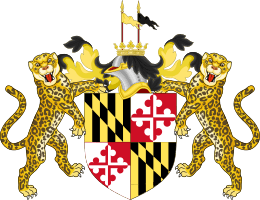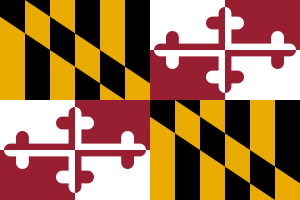Baron Baltimore
| Barony of Baltimore | |
|---|---|
 | |
| Creation date | 1625 |
| Monarch | James I |
| Peerage | Peerage of Ireland |
| First holder | George Calvert, 1st Baron Baltimore |
| Present holder | Extinct |
| Remainder to | the male heirs of the body lawfully begotten |
| Extinction date | 4 September 1771 |
Baron Baltimore, of Baltimore Manor in County Longford, was a title in the Peerage of Ireland. It was created in 1624 for George Calvert and became extinct on the death of the sixth Baron in 1771. The title was held by several members of the Calvert family who were proprietors of the palatinates Avalon in Newfoundland and Maryland (later the U.S. state of Maryland). In the context of United States history, the name Lord Baltimore usually refers to Cecil Calvert, 2nd Baron Baltimore after whom the city of Baltimore, Maryland, is named. His younger brother Leonard Calvert was the first Governor of Maryland.
As members of the Irish peerage, the Lords Baltimore were able to sit in the British House of Commons. Irish peerages were often used as a way of creating peerages which did not grant a seat in the British House of Lords and so allowed the grantee to sit in the House of Commons in London. As a consequence, many Irish peers had little or no connection to Ireland.
Barons Baltimore (1625 to 1771/1776/1835)
- Sir George Calvert, 1st Baron Baltimore, (1579–1632),
- Cecilius Calvert, 2nd Baron Baltimore, (1605–1675),
- Charles Calvert, 3rd Baron Baltimore, (1637–1715),
- Benedict Leonard Calvert, 4th Baron Baltimore, (1679–1715),
- Charles Calvert, 5th Baron Baltimore, (1699–1751),
- Frederick Calvert, 6th Baron Baltimore, (1731–1771),
- Henry Harford, (illegitimate son), (1758/1760–1835), (5th and Last Lord Proprietor of the Province of Maryland, 1771–1776).
Other notable Calverts
Though the barony is extinct, the Barons Baltimore left a number of descendants, including:
- Leonard Calvert (1606–1647), the first Governor of the Province of Maryland. He was the second/younger son of Sir George Calvert, first Baron and "Lord Baltimore", (1579–1632), to which the colony of Maryland was originally granted in 1632, and the younger brother of Cecilius Calvert, the second Baron Baltimore or "Lord Baltimore" to which the Maryland grant was extended and continued and planned sending the first group of settlers on the ships "The Ark" and "The Dove" in late 1633 and early 1634.
- Phillip Calvert, (born c. early 17th Century), proprietary/colonial Governor of Maryland during a brief period in 1660 or 1661. He was appointed by the royally chartered proprietor of the Province of Maryland, Charles Calvert, 3rd Baron Baltimore, as a caretaker to replace insurgent leader Josias Fendall (1628–1687), who had assumed the governorship.
- Captain Charles Calvert, (1680–1734), provincial/colonial Governor of Maryland in 1720, at a time when the Calvert family had recently regained control of their proprietary colony. He was appointed Governor by his cousin Charles Calvert, 5th Baron Baltimore.
- Benedict Leonard Calvert, (1700–1732), the proprietary/colonial Governor of Maryland from 1727 through 1731, appointed by his brother, Charles Calvert, 5th Baron Baltimore.
- Benedict Swingate Calvert, (c. 1730–1788), the illegitimate son of Charles Calvert, 5th Baron Baltimore, the third Proprietor/Colonial Governor of Maryland. Loyalist and Judge of the Land Office prior to the American Revolution, (1775–1783).
- Eleanor Calvert (1758–1811), daughter-in-law of Martha Dandridge Washington and the stepdaughter-in-law of the General of the Continental Army and first President of the United States, George Washington, (1732-1799).
- Henry Harford, (1758–1834), 5th and last Proprietor of Maryland. He was the illegitimate son of Frederick Calvert, 6th Baron Baltimore.
- Charles Benedict Calvert, (1808–1864), a U.S. Representative, (Congressman) from the Sixth Congressional District of Maryland (western panhandle of state), serving one term from 1861–1863, also founder of the Maryland Agricultural College near College Park, Maryland in 1856, (now the The University of Maryland at College Park, after 1920) and his nearby ""Riversdale"" plantation in Prince George's County off U.S. Route 1.
Legacy

There are several locations in Maryland named after the Barons Baltimore ("Lords Baltimore"), including Baltimore County, Baltimore City. Calvert County, Cecil County, Charles County, Frederick County, Leonardtown, St. Leonard and Calvert Cliffs. There is also Charles Street and Calvert Street in Baltimore.
Wife of Cecilius Calvert, Anne Arundell's namesake Queen survives in that of Anne Arundel County, Maryland. His name survives also in that of Cecil County, Maryland, Cecil Avenue, Cecil Elementary School and Calvert Street in Baltimore, along with another Calvert Street (alley) in Brooklyn (a South Baltimore city neighborhood bordering suburban Anne Arundel County) and Calvert Street in Washington, D.C..
Harford County is named for Henry Harford, (1758/1760-1835), the illegitimate son of Frederick Calvert, the 6th and last Baron and "Lord Baltimore" (1731–1771). Leonardtown, Maryland, now county seat of St. Mary's is named for the nephew of the second Lord Baltimore Cecilius, the 28-year-old Leonard Calvert (1606–1647), who arrived in the Colonial settling expedition 1634 and set up the provincial government in the new capital of St. Mary's City.
The main downtown street in Cumberland, Maryland is named Baltimore Street, along with Baltimore Avenue, the main north-south highway of commercial business along the Atlantic coast to the resort town of Ocean City. The Baltimore Road, which runs through the town of Bladensburg was made famous due to its role in the Battle of Bladensburg and the subsequent "Burning of Washington" during the War of 1812.
On the Avalon Peninsula in the Province of Newfoundland and Labrador of the northeastern Dominion of Canada, there is a settlement named Calvert, and in nearby Ferryland there is a "Baltimore School". There are also several other towns and villages across North America in the several states with the name of "Baltimore", "New Baltimore" or "Old Baltimore".
A life-sized bronze statue on a granite pedestal of the second Lord Baltimore, Cecilius Calvert, (1605–1675), is located on the steps of the western end at the St. Paul Street entrance of the Baltimore City Circuit Court House, the third courts structure on the nearby colonial-era Courthouse Square site (located to the east along North Calvert Street), constructed 1896–1900 (now renamed the Clarence M. Mitchell, Jr. Court House since 1985 for a noted local and Civil Rights Movement leader, Clarence M. Mitchell, Jr., [1911–1984], known as "The 101st Senator") in Baltimore, Maryland. The Cecilius Calvert statue, sponsored by the Society of Colonial Wars in the State of Maryland, was dedicated November 21, 1908, and now faces a fountain and tree-shaded small plaza/park across the street, developed/laid out in 1964, between East Fayette and East Lexington Streets.
Before the American Revolution, a common flag used by military units of the colonial militia of the Province of Maryland was known as the Calvert Arms Flag. This flag had the original Union Jack from the Acts of Union 1707 as a canton in the upper corner, with a St. George's Cross and a St. Andrew's Cross to represent the patron saint of England and Scotland, respectively.
This Union Jack canton in the upper corner of the banner over the black and gold (yellow) chevrons depicted on the Calvert family's shield and coats-of-arms. Today, this historical colonial flag is often displayed throughout the state, especially at historical, heritage and festival events. The modern flag of the State of Maryland still bears the Baltimore coats-of-arms and shield.
In addition, numerous local businesses, companies and corporations use the "Baltimore", "Calvert", "Lord Baltimore", "Cecil", "Charles", "Benedict", and "Frederick" names for their identity and local connections.
See also
References
- Mosley, Charles (1999). Burke's Peerage and Baronetage. 2 vols (106th ed.).
- Mosley, Charles (2003). Burke's Peerage and Baronetage. 2 vols (107th ed.).
- Cokayne, George E.; Vicary Gibbs, Peter; Doubleday, Harry; de Walden, Lord Howard (1958). The Complete Peerage of England, Scotland and Ireland, Great Britain and Northern Ireland, extant, dormant, abeyant and extinct. XIV vols.
External links
| Wikisource has the text of a 1905 New International Encyclopedia article about Baron Baltimore. |
- Calvert Family Tree Retrieved Jul 10 2013
- Calverts at http://thepeerage.com Retrieved Jan 24 2010
.jpg)